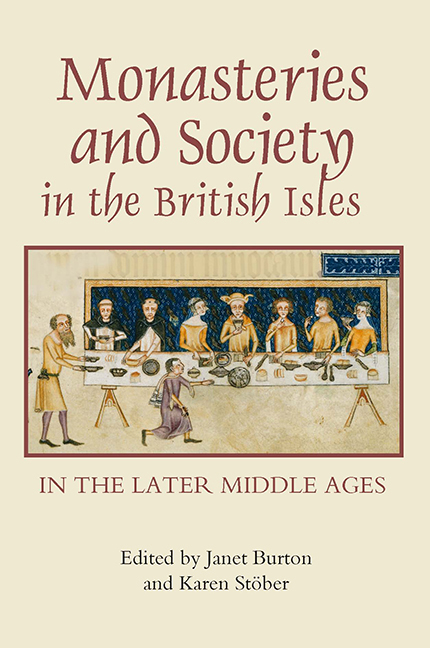Book contents
- Frontmatter
- Contents
- List of illustrations
- Acknowledgements
- List of contributors
- Abbreviations
- Introduction
- The Meeting of the Worlds
- Religious Houses and their Patrons and Benefactors
- Female Communities: Nuns, Abbesses and Prioresses
- Monasteries and Education
- Monasteries and Urban Space
- Religious Houses in the Regions
- 14 Monasteries in medieval Cornwall: Mediocrity or merit?
- 15 Monasteries and society in sixteenth-century Yorkshire: The last years of Roche Abbey
- Index of Religious Houses mentioned in the text
- Index
- Miscellaneous Endmatter
15 - Monasteries and society in sixteenth-century Yorkshire: The last years of Roche Abbey
from Religious Houses in the Regions
Published online by Cambridge University Press: 24 October 2017
- Frontmatter
- Contents
- List of illustrations
- Acknowledgements
- List of contributors
- Abbreviations
- Introduction
- The Meeting of the Worlds
- Religious Houses and their Patrons and Benefactors
- Female Communities: Nuns, Abbesses and Prioresses
- Monasteries and Education
- Monasteries and Urban Space
- Religious Houses in the Regions
- 14 Monasteries in medieval Cornwall: Mediocrity or merit?
- 15 Monasteries and society in sixteenth-century Yorkshire: The last years of Roche Abbey
- Index of Religious Houses mentioned in the text
- Index
- Miscellaneous Endmatter
Summary
Between 1536 and 1540 the government of Henry VIII destroyed seventy-nine religious houses in Yorkshire containing well over a thousand monks, friars and nuns. At first sight there would seem to be little cause for singling out the apparently unremarkable Cistercian abbey of Roche, but the fortuitous survival of three manuscripts, a near contemporary account of its suppression, an ordination certificate of 1555 alluding to the apparent revival of the monastery, and, most intriguingly of all, topographical notes on neighbouring churches attributed to one of its members, provides more detailed information on the process and consequences of the Dissolution both for the monks and the local inhabitants than exists for almost anywhere else in the county. After briefly exploring the relationship between the abbey and lay society in the earlier part of the sixteenth century, this paper will use this evidence to examine reactions to the surrender of Roche in the summer of 1538, assess the significance of the events in the Marian period, and follow the fortunes of the last generation of monks.
Founded about 1147 by two local landowners in a valley in the parish of Maltby some five miles from the small town of Tickhill in the extreme south of the West Riding, Roche enjoyed a clear annual revenue of around £222 in 1535. This placed it way below Fountains, by far the richest Yorkshire Cistercian abbey valued at over £1000 a year, and the considerably less wealthy Kirkstall, Meaux, and Rievaulx, at about the same level as Byland and Jervaulx, and substantially above Sawley, the only Cistercian monastery in the county with an annual income below £200. In other words it possessed a reasonable competency, which allowed it to maintain a convent of around eighteen monks, but could in no sense be regarded as a major religious house.
Although it had acquired a few dispersed properties over the years, its chief estates lay in a relatively confined area in the vicinity of the abbey in south Yorkshire, north Nottinghamshire and north Lincolnshire, which constituted its main sphere of influence at the end of the Middle Ages. On entering religion Cistercians usually changed their surname to that of their place of origin.
- Type
- Chapter
- Information
- Publisher: Boydell & BrewerPrint publication year: 2008



